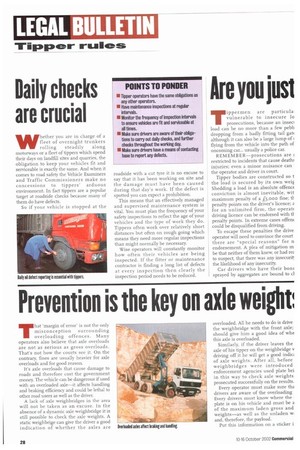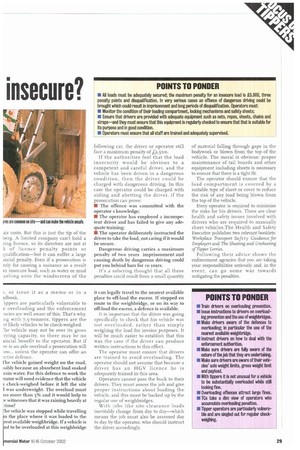Prevention is the key on axle weight
Page 28

Page 29

If you've noticed an error in this article please click here to report it so we can fix it.
That 'margin of error' is not the only misconception surrounding overloading offences. Many operators also believe that axle overloads are not as serious as gross overloads. That's not how the courts see it. On the contrary, fines are usually heavier for axle overloads and for good reason.
It's axle overloads that cause damage to roads and therefore cost the government money. The vehicle can be dangerous if used with an overloaded axle—it affects handling and braking efficiency and could be lethal to other road users as well as the driver.
A lack of axle weighbridges in the area will not be taken as an excuse. In the absence of a dynamic axle weighbridge it is still possible to check the axle weights. A static weighbrige can give the driver a good indication of whether the axles are
overloaded. All he needs to do is drive the weighbridge with the front axle; should give him a good idea of whe this axle is overloaded.
Similarly, if the driver leaves the axle of his tipper on the weighbridge v driving off it he will get a good indic; of axle weights. After all, before weighbridges were introduced enforcement agencies used plate bri in this way to check axle weights prosecuted successfully on the results.
Every operator must make sure tha drivers are aware of the overloading Every drivers must know where the plate is on his vehicle and must be a of the maximum laden gross and weights—as well as the unladen w, and, therefore, the payload.
Put this information on a sticker i ), or issue it as a memo or in a id book.
"ippers are particularly vulnerable to e overloading and the enforcement ricies are well aware of this. That's why, ng with 7.5-tonners, tippers are the st likely vehicles to be check-weighed. "he vehicle may not be over its gross rying capacity, so there may be no ancial benefit to the operator. But if re is an axle overload a prosecution will ow... unless the operator can offer an ictive defence.
rhe vehicle gained weight on the road, ;sibly because an absorbent load soaked rain water. For this defence to work the mator will need evidence that the vehicle s check-weighed before it left the site was underweight. The overload must no more than 5% and it would help to e witnesses that it was raining heavily at time!
he vehicle was stopped while travelling rn the place where it was loaded to the rest available weighbridge. If a vehicle is nd to be overloaded at this weighbridge it can legally travel to the nearest available place to off-load the excess. If stopped en route to the weighbridge, or on its way to off-load the excess, a defence is available.
It is important that the driver was going specifically to check that his vehicle was not overloaded, rather than simply weighing the load for invoice purposes. It will be much easier to establish that this was the case if the driver can produce written instructions to this effect.
The operator must ensure that drivers are trained to avoid overloading. The operator should not assume that because a driver has an HGV licence he is adequately trained in this area.
Operators cannot pass the buck to their drivers. They must assess the job and give proper instructions about loading the vehicle, and this must be backed up by the regular use of weighbridges.
With jobs like site clearance loads inevitably change from day to day—which means the job must also be assessed day to day by the operator, who should instruct the driver accordingly.




































































































































































